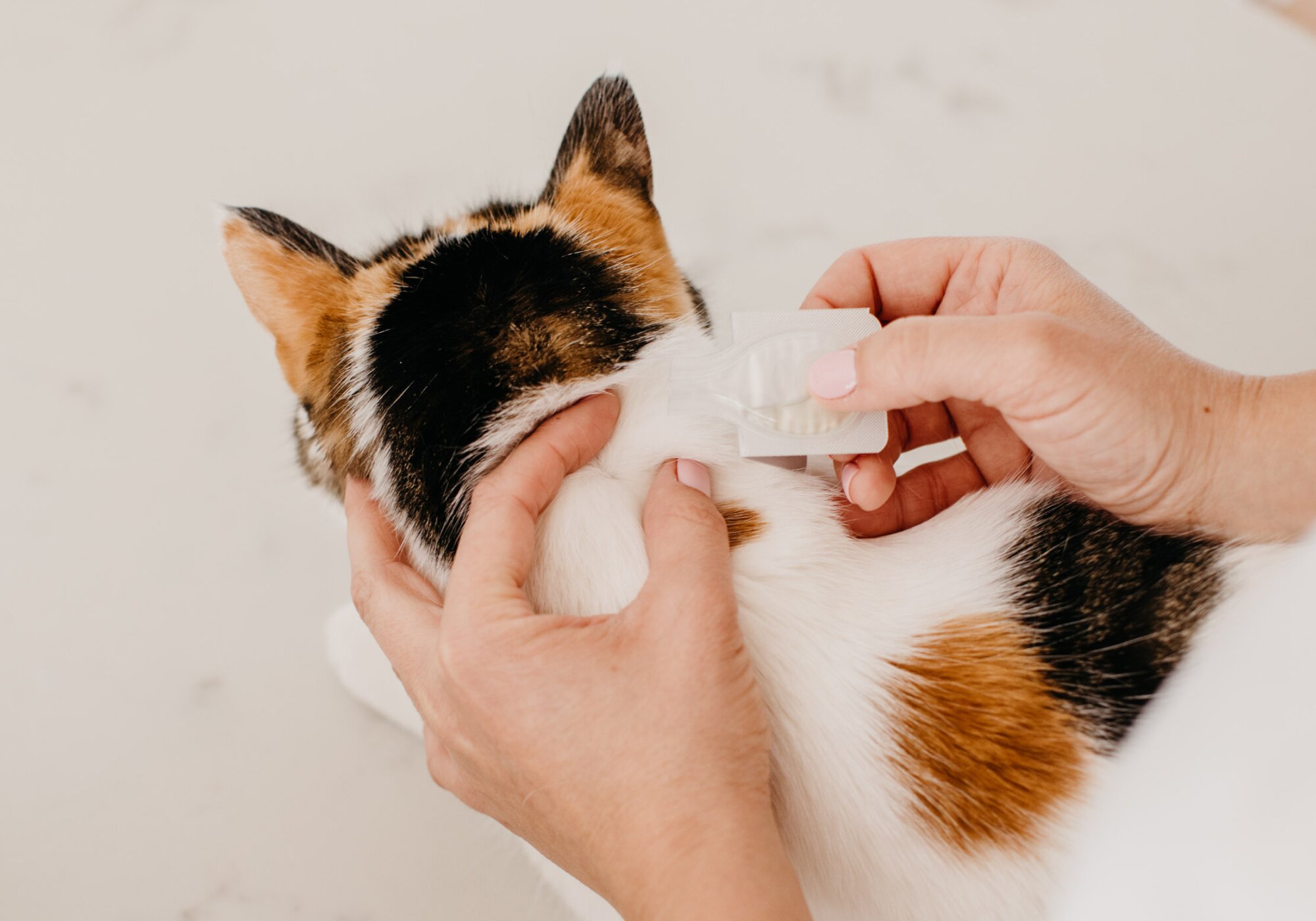Looking for different types of flea treatment for your dog or cat? There’s a lot to consider when it comes to flea control.
If you’ve narrowed your search to topicals you’ll want to know what to look for and when, where, and how to apply flea medicine. But the instructions for putting it on aren’t always straightforward. Keep scrolling for expert advice on applying topical flea treatments.

What to look for in flea and tick protection
Form factor
There are a variety of methods for killing fleas on pets. Each has its own benefits and risks. When searching for an effective solution you may consider different form factors like:
- Wearables (like flea collars)
- Oral medications (chew or tablet form)
- Topical solutions
While other treatments are often touted as the best for your pets, topicals (flea drops for cats or spot-on treatments) are typically the most effective. They kill and prevent parasites from biting and infecting your pet.
Brand
While vet-quality products are well-known across the country, you don't necessarily need name-brand products to get the job done. Some common name brands include:
- Wags Advance® for Dogs
- Frontline Plus for Dogs
- K9 Advantix II
- Advantage Multi
Ingredients
The right solution can give your pet a competitive advantage against fleas and ticks by killing and repelling them from your pet. Look for these active ingredients:
- Fipronil
- Permethrin (not safe for cats)
- Imidacloprid
- Nitenpyram
- Methoprene
- Pyriproxyfen
Efficacy
Certain ingredients help break the life cycle of various parasites. Make sure your medication covers:

How to apply flea treatment to your dog

The steps for applying flea treatment to your dog aren’t always the same. Before you begin, start by reading through the instructions provided in the package.
The amount of formula in a topical or spot-on flea treatment often aligns with your dog’s weight. If they’ve gained or lost weight since your last treatment, you may need a different dose. Additionally, there are weight minimums so confirm that your dog's weight still matches the range listed on the box.
Here's how to apply flea and tick treatment in 5 easy steps:
- Grab some treats and a helpful friend to hold your pet
- Remove the tube from the box
- Hold the tube vertically and open the tip (may require scissors)
- Follow the instructions to apply as directed
- Throw the empty applicator tube in the trash (never put unused treatment down any drain)
When
While minimum age and weight vary by product, new puppies should be at least 7-10 weeks old and 3-5 pounds before using a topical flea preventative. Make sure you check the pack and your dog’s weight each time to apply the right dose.
The best protection from parasites comes with regular application of their topical flea and tick treatment. This means that you should be reapplying every 30 days.
There’s no right or wrong time of day to treat your pet. But, you shouldn’t wash or bathe your dog for at least 48 hours before or after applying. Doing so strips away the natural oils on your pet's skin and decreases the effectiveness of the product. So, avoid contact with treated areas until dry.
Where

To ensure your pet keeps fleas and ticks at bay, you’ll want to apply the formula in the right spot. While every topical treatment is different there are a few things to keep in mind.
- Comb or part the hair near their neck and shoulder blades
- Ensure the treatment is applied directly to their skin, not their fur
- Keep your dog sitting or standing upright
- Consider applying the medication outdoors or in a non-carpeted area
VET TIP
Some treatments require you to apply the solution in several spots to the skin along your dog’s spine. If so, be sure to start at your pet's neck and end at the base of their tail. Part their fur with a flea comb and ensure your pet doesn't lick the medication from their skin.

How to apply flea treatment to your cat

Just like applying flea treatment to dogs, there are a few ways to properly apply topicals to your cats. As always, read through the provided instructions on your package. And, be sure to follow these tips for when and where you should treat your cat.
While every applicator tube is different, these are the most common tips for applying topical flea treatment to cats:
- Ask another person for help holding your cat
- Remove the tube from the box
- Hold the tube vertically and open the tip (make require scissors)
- Follow the instructions to apply as directed
- Throw the applicator in the trash (never put unused treatment down any indoor or outdoor drain)
When
Depending on the formula, your cat may need to be a specific weight and age. This can vary from 1.5 to 5 pounds and 8 to 12 weeks. As kittens grow and age, you may need to adjust their dosage. Before applying, confirm your cat's weight still matches the range listed on the box.
You may be wondering, how often can you apply flea medicine to cats? Just like dogs, you should only treat your cat with topical flea medicine once every 30 days.
As with dogs, your cat should be completely dry before treatment. If you give them a flea bath prior, make sure you wait at least 48 hours before applying treatment. Then, keep your cat dry for at least 24 hours to ensure the liquid spreads evenly.
Where

If you have a multi-pet household, it's important to keep your treated cat away from all other pets. Make sure your cats don't rub against each other or get into bedding or articles of clothing post-application. Consider keeping your cat in a separate bedroom to avoid cross-contamination.
Some topical cat flea treatments (meant for dogs) can be deadly for cats. Permethrin, a common chemical used in spot-on formulas, is highly toxic for cats.
Additionally, there are a few ways to ensure you are applying treatment in the right spots.
- Part the hair near your cat's neck (base of the skull)
- Apply the cat treatment in one spot directly on their skin (not their fur)
- Keep your cat sitting or standing to ensure liquid doesn’t run off their side

Why spot-on flea treatment works
Spot-on flea treatment is great for a few reasons. But how does flea medicine work? Keep reading to learn the benefits and risks of topical flea products.
1. Prevent fleas, bites, and infections.
Oral treatments protect your pets after a flea bite, while topical treatments prevent the bite from happening in the first place. Topical flea treatments contain a repellent that keeps fleas and ticks away from your pet, so fleas don't have to bite or feed on your pet's skin for the formula to work.
2. Kill adult fleas (flea eggs & larvae) at the source.
Topicals also contain active ingredients that help break the typical flea life cycle of fleas (including flea eggs and flea larvae), ticks, lice, and mosquitoes. Though extremely rare, your pet may experience a few side effects. Watch out for any sign of infection like itching, lethargy, and digestive issues, and contact your veterinarian right away if symptoms worsen.
3. Save on expensive treatments and trips to the vet.
Topicals are generally more affordable than other preventatives. Plus, oral treatments require a prescription, so you'll need to speak with your veterinarian beforehand. However, if you're looking for protection from worms, you'll need another solution specifically for heartworm. Contact a licensed veterinarian for advice before starting your pet's essential care routine.
Let's face it — problems like fleas, ticks, and worms are the worst. But being a good pet parent means giving your pet the best advantage against harmful pests. The best way to keep indoor and outdoor cats and dogs flea-free, and avoid a flea infestation, is through monthly prevention and by treating your home.

